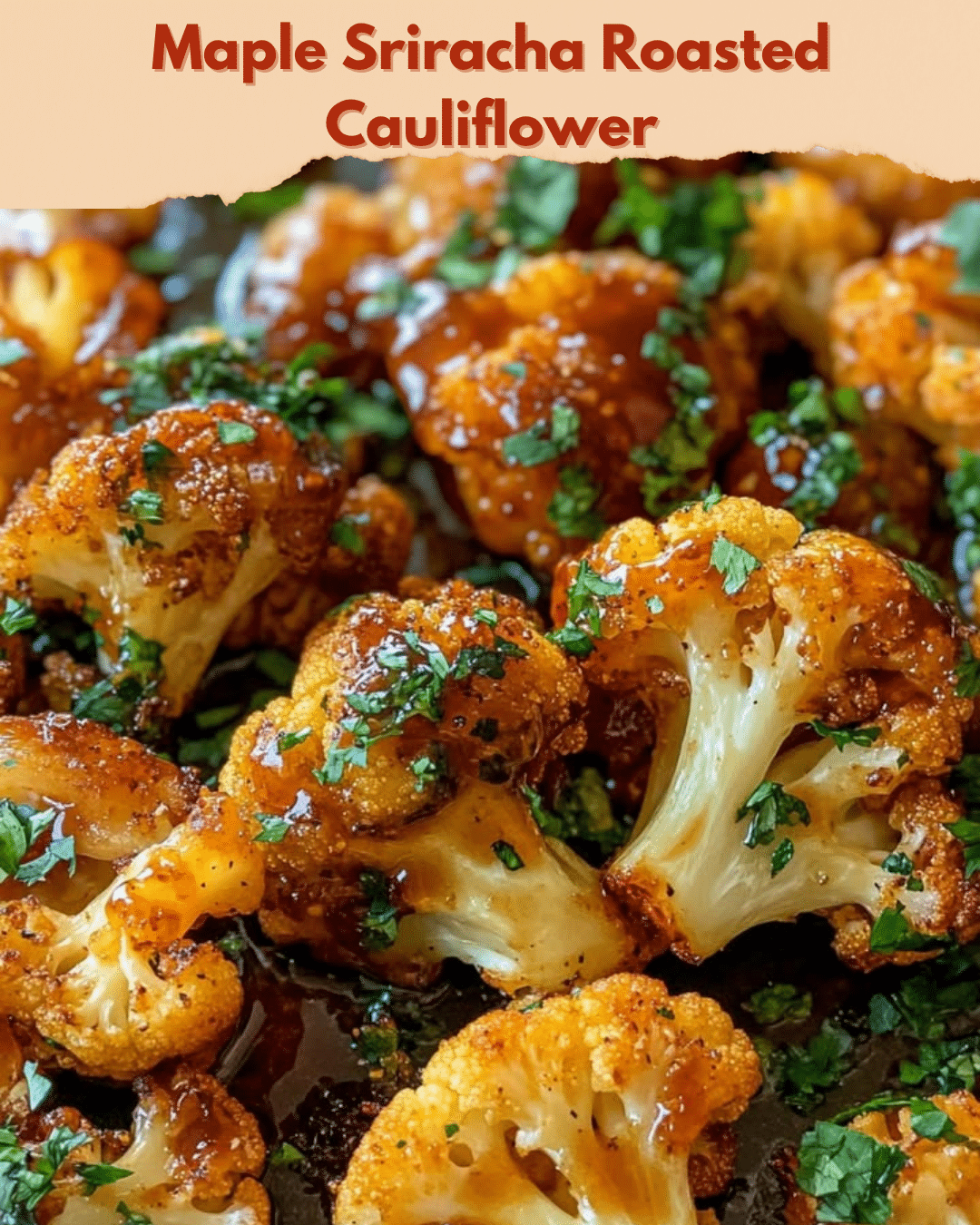Maple Sriracha Roasted Cauliflower: A Sweet and Spicy Delight
Imagine a dish where the bold flavors of sriracha meet the comforting sweetness of maple syrup, all enveloped in tender, crispy cauliflower. This Maple Sriracha Roasted Cauliflower recipe is a culinary adventure, designed to excite your palate with its fiery kick and sweet undertones. Roasting cauliflower brings out its natural nutty flavor, creating a dish that’s both indulgent and nutritious.
Quick Recipe Highlights
- Flavor Profile: A perfect blend of sweet and heat, with maple syrup mellowing down the spiciness of sriracha to create a harmonious fusion.
- Texture: Delightfully crispy on the outside, tender on the inside, giving it a satisfying bite.
- Aroma: A tantalizing aroma with hints of caramelized maple and spicy chili peppers that fill the kitchen as it roasts.
- Visual Appeal: Golden-brown florets speckled with a beautiful glaze, enhanced with fresh herbs for a pop of color.
- Skill Level Needed: Simple enough for novice cooks, requiring only basic roasting skills and ingredient preparation.
- Special Equipment: A large baking sheet and a mixing bowl make this dish nearly mess-free and easy to prepare.
Recipe Overview
- Difficulty Level: This recipe is easy to execute, with straightforward steps that involve mixing ingredients and roasting them in an oven, making it suitable for cooks of all levels.
- Category: Perfect as an appetizer, side dish, or a light main course, offering versatility in your meal plans.
- Cuisine: This dish draws from fusion cuisine, merging Asian and North American flavors for a unique taste experience.
- Cost: Budget-friendly, utilizing common pantry items with cauliflower as the main ingredient, making it economical for any household.
- Season: Ideal year-round, but particularly satisfying in the fall when cauliflower is at its peak freshness.
- Occasion: Suitable for casual dinners, parties, and even holiday gatherings as a sophisticated, yet simple dish.
Why You’ll Love This Recipe
The taste is a delightful contradiction, combining the warm sweetness of maple syrup with the fiery zest of sriracha. Each bite offers a contrast of flavors that dance on your tongue, invigorating your senses and leaving you yearning for more.
Convenience is at the heart of this dish. With minimal prep time and everyday ingredients, it is perfect for weeknight dinners or impromptu gatherings. Roasting offers a hands-off cooking method, allowing you to multitask while your oven works its magic.
When it comes to nutrition, this recipe stands out. Cauliflower is a nutrient-dense vegetable, rich in vitamins C and K, along with fiber and other essential minerals. The use of maple syrup as a natural sweetener offers a healthier alternative to processed sugars, ensuring you enjoy a guilt-free treat.
In a social setting, this dish is a conversation starter. The uncommon combination of flavors piques interest, inviting guests to savor and discuss. It becomes more than just a dish; it’s an experience shared over delightful exchanges.
Finally, its cost-effectiveness cannot be overstated. The ingredients are inexpensive and accessible, meaning feeding a crowd won’t stretch your budget. It’s a recipe that proves culinary excellence doesn’t have to come with a hefty price tag.
Historical Background and Cultural Significance
Originating as an experiment in culinary fusion, the Maple Sriracha Roasted Cauliflower reflects innovation in modern cooking. The sriracha sauce, with roots in Thai cuisine, brings an element of spice that is both traditional and contemporary. Maple syrup, native to North America, introduces a sweet complexity emblematic of autumnal harvests.
Cauliflower itself holds a special place in many cultures. Used in Indian, Mediterranean, and European cuisines, it is celebrated for its adaptability and ability to absorb flavors. This dish’s significance lies in its homage to multicultural influences, offering a nod to tradition while embracing new taste territories.
The evolution of this recipe mirrors changing dining habits, with more audiences seeking plant-based, nutrition-focused meals. It reflects a growing enthusiasm for incorporating vegetables in thrilling and eclectic ways, redefining what vegetable dishes can offer.
Regionally, variations of this dish appear in different forms. Some may use honey or agave in place of maple syrup, altering the dish’s sweetness. Others might introduce additional flavors like lime or cilantro, creating a varied palate that represents regional preferences and produce availability.
Ingredient Deep Dive
Cauliflower: Known as the versatile vegetable, cauliflower is a staple in many diets for its ability to transform into various textures and flavors. Its origins are traced back to ancient Asia, with significant consumption in European countries. Rich in vitamins and minerals, it offers substantial health benefits, including high fiber content and the ability to improve digestive health. When selecting, opt for firm and unblemished heads with bright green leaves, indicative of freshness. Store in a cool, dry place, ideally in the crisper drawer of the refrigerator, to maintain its quality. If cauliflower isn’t on hand, broccoli or Romanesco can serve as suitable substitutes without compromising the dish’s characteristics.
Maple Syrup: A classic North American ingredient, pure maple syrup is harvested from the sap of sugar maple trees. Its deep amber color and rich sweetness make it a natural sweetener preferred by health-conscious cooks. It contains antioxidants and minerals like manganese and zinc, contributing to a balanced diet. When purchasing, look for Grade A dark amber syrup, known for its robust flavor profile. Store it in a cool pantry before opening, and refrigeration is recommended afterwards to preserve its quality and prevent crystallization. Honey or agave nectar may substitute maple syrup if desired, though each brings its unique influence on the dish’s final taste.
Common Mistakes to Avoid
- Not preheating the oven: This can result in an uneven roast, with some parts overcooked and others underdone.
- Overcrowding the baking sheet: Ensure each cauliflower floret has ample space, allowing them to roast rather than steam.
- Using low-quality maple syrup: Cheap alternatives can alter the flavor and texture, so always opt for pure maple syrup.
- Skimping on seasoning: Be generous with salt and spices to enhance the dish’s flavor dynamics.
- Skipping the oil: This can lead to dry florets; a slight coating ensures they remain moist and flavorful.
- Roasting at too low a temperature: It can result in soggy cauliflower rather than achieving a crispy texture.
- Forgetting to flip halfway through roasting: Doing so ensures an even golden-brown finish on all sides.
- Using stale sriracha: Check for freshness to maintain consistent spiciness within the dish.
- Not adjusting for taste preferences: Balancing sweet and spicy elements to suit personal preferences can enhance enjoyment.
Essential Techniques
Achieving the perfect roast is crucial for unlocking cauliflower’s full flavor potential. The high heat of the oven transforms the florets, drawing out their natural sugars and creating a caramelized exterior. Mastering this technique requires attentiveness—a golden crispy edge signals success. Use visual cues and ensure even spacing on the baking sheet to avoid steaming, which results in a less favorable texture.
Balancing flavors is another key element for this dish. The interplay of spice and sweetness demands precision; too much heat can overpower, while too little sweetness might leave the dish unbalanced. Taste as you go and adjust the ratio of sriracha to maple syrup accordingly.
Pro Tips for Perfect Maple Sriracha Roasted Cauliflower
Fresh is best: Choose the freshest cauliflower heads for maximum flavor and texture.
Customize the spice: Adjust the sriracha to your heat preference. Feel free to add extra for a more substantial kick.
Garnish smartly: Fresh herbs like cilantro or parsley add color and a burst of freshness. Squeeze of lime before serving elevates the dish further, adding acidity that complements the sweetness.
Timing matters: Keep a close watch during roasting to prevent burning. A light char enhances flavor, but too much can create bitterness.
Consistency in size: Cut florets into uniform pieces for even cooking throughout.
Rest before serving: Allow it to cool slightly after roasting for flavors to meld and enhance.
Variations and Adaptations
Regional variations: Incorporate local spices or herbs to reflect regional taste preferences.
Seasonal adaptations: Swap cauliflower for other in-season vegetables like Brussels sprouts in winter or zucchini in summer.
Dietary modifications: For a low-carb version, reduce the maple syrup and add more spices for depth.
Flavor variations: Experiment with additional ingredients such as garlic or fresh ginger for layers of complexity.
Texture modifications: Include nuts such as almonds or walnuts for added crunch and contrast.
Presentation alternatives: Serve it as a warm salad by adding leafy greens, nuts, and a simple dressing for an elegant twist.
Serving and Presentation Guide
Elegance in simplicity: Keep the presentation minimal with a white plate to accentuate the dish’s vibrant colors.
Garnishing ideas enhance with a sprinkle of fresh herbs or a light dusting of smoked paprika for color and flavor.
Consider traditional accompaniments like crusty bread or a creamy dip, complementing the dish’s flavors.
Opt for modern serving suggestions by pairing with a quinoa salad or a curried yogurt sauce for a contemporary take.
Temperature considerations: Serve warm as it retains the best flavor and texture profile.
Portion control tips serve in small bowls or as part of a multi-course meal to keep portions balanced and the dining experience varied.
Wine and Beverage Pairing
Wine pairings: A Riesling or Gewürztraminer complements the dish’s sweet-spicy profile, offering a balance that enhances both the wine and food.
Non-alcoholic alternatives: Opt for a ginger-infused iced tea or lime soda for refreshing accompaniment without alcohol.
Temperature considerations Ensure beverages are served chilled to counterbalance the dish’s heat and complement flavors.
Serving suggestions: Serve in elegant glassware to elevate a casual meal into a sophisticated dining experience.
Storage and Shelf Life
Proper storage methods involve keeping leftovers in an airtight container in the refrigerator, maintaining quality for up to three days.
Temperature requirements: Ensure storage in a cool environment to prevent spoilage.
Container recommendations: Use glass containers to preserve taste and avoid odor absorption, a common issue with plastic.
Signs of spoilage include an off smell or mushy texture; discard if observed.
Reheating instructions: Gently warm in the oven to regain crispiness and prevent sogginess.
Freezing guidelines: While possible, freezing might alter texture; if necessary, freeze in an airtight container and reheat from frozen in a preheated oven.
Make Ahead Strategies
Prep timeline: You can prepare ingredients a day ahead, storing them separately to ensure freshness upon roasting.
Storage between steps: Keep components like sauce and chopped cauliflower in different containers to prevent sogginess.
Quality impact assessment: Prepping in advance should not detract much from flavor or texture when reheated properly.
Assembly tips: Recombine ingredients just before roasting for optimal freshness.
Reheating guidelines: Best reheated in a hot oven to restore original texture, avoiding traditional microwaving that can soften.
Fresh element additions: Add fresh garnishes or a fresh squeeze of lime immediately before serving to enhance vibrancy.
Scaling Instructions
For halving the recipe, simply halve all ingredients, maintaining ratios for consistent flavor.
Doubling or tripling: Increase ingredient quantities proportionally; ensure enough roasting space or work in batches to prevent crowding.
Equipment adjustments may include multiple baking sheets to accommodate extra portions without altering cooking times dramatically.
Timing modifications may require careful monitoring as oven capacity impacts roasting time.
Storage considerations: Larger batches might require dividing into several containers for optimal storage conditions and ease of access.
Nutritional Deep Dive
This dish is rich in essential macronutrients, with cauliflower providing a low-calorie, high-fiber base.
Micronutrient analysis reveals high levels of vitamin C, vitamin K, and antioxidants aiding in overall health.
Health benefits include anti-inflammatory properties and heart health support due to key vitamins and minerals.
Dietary considerations: Suitable for most diets, though those monitoring sugar intake should adjust maple syrup accordingly.
Portion analysis: A serving offers a reasonable caloric count, aligning with balanced dietary goals.
Weight management tips: Incorporate this dish into a varied diet featuring lean proteins and green vegetables for holistic nutrition.
Dietary Adaptations
Gluten-free: Naturally gluten-free, making it an excellent choice for those with gluten sensitivities.
Dairy-free: The recipe is already dairy-free, enhancing its suitability for lactose-intolerant individuals.
Vegan: Completely vegan, aligning with plant-based dietary requirements.
Low-carb: Reduce maple syrup for a low-carb variant without sacrificing too much flavor.
Keto: Modify spices and reduce sweeteners to craft a keto-friendly version.
Paleo: Aligns with paleo guidelines when maple syrup is moderated.
Low-FODMAP: Suitable with slight modifications, like using garlic-infused oil rather than whole garlic.
Other specific diets: Versatile enough to adapt to other dietary needs with minor ingredient adjustments.
Troubleshooting Guide
For texture issues, ensure proper roasting temperature and avoid overcrowding, which causes sogginess.
Balancing flavor may involve tweaking ratios of sriracha and maple syrup to personal taste preference.
Address temperature problems by ensuring consistent oven settings and avoiding premature opening.
Equipment challenges can be overcome by utilizing suitable trays and ensuring even distribution.
Ingredient substitutions like different sweeteners can impact taste—adapt carefully.
Timing concerns usually relate to variable oven performance; monitor times closely to adapt as needed.
Recipe Success Stories
Community feedback highlights wide-loving praise for the recipe’s unique flavor harmony, often shared at potlucks and gatherings with success.
Variation successes include creative additions like smoked paprika or chili flakes for extra depth.
Adaptation stories from readers suggest using local honey or spices for a regionally inspired twist.
Reader suggestions inspired the addition of lime juice for an acidic balance that elevates the dish.
Photography tips: Capture the dish under natural light to emphasize its vibrant colors and texture.
Frequently Asked Questions
Yes, although fresh is preferred for texture, you can use frozen cauliflower. Ensure it’s thawed and drained well to avoid excess moisture during roasting.
Is it very spicy?
The dish has a moderate spice level, but you can adjust the amount of sriracha to suit your taste preferences.
What can I serve it with?
It pairs well with grains like quinoa or rice, and you can also serve it alongside protein sources like grilled chicken or tofu.
How do I store leftovers?
Store in an airtight container in the fridge for up to 3 days and reheat in the oven to maintain crispiness.
Can I make it without maple syrup?
Substitute with other sweeteners like honey or agave, but it will alter the flavor profile slightly.
What other vegetables can I use?
Broccoli, Brussels sprouts, or carrots can be used as substitutes or blends for varied flavors and textures.
How do I ensure even roasting?
Keep florets of uniform size, use a hot oven, and avoid overcrowding the tray for consistent roasting.
What if I don’t have sriracha?
Other hot sauces can substitute, although sriracha’s unique flavor will differ.
Does it freeze well?
While possible, freezing can affect texture. If you choose to freeze it, reheat in a hot oven to regain some crispness.
How can I reduce the sugar content?
Reduce the maple syrup amount and enhance the spices for more depth instead of added sweetness.
Are there other ways to serve it?
Try serving in tacos or over a salad for a creative use of the dish.
Is it kid-friendly?
Modify the spice level to make it more palatable for children, adjusting sriracha to taste.
Additional Resources
Explore related recipes that pair brilliantly such as roasted garlic quinoa or a robust bean salad for complete meal ideas.
Technique guides for roasting vegetables can enhance your skills in coaxing flavor and texture from various produce.
Ingredient information on the benefits and uses of maple syrup and hot sauces can broaden culinary knowledge and application.
Equipment recommendations ensure the best tools for preparing roasted dishes, ranging from baking sheets to mixing bowls.
Seasonal variations offer inspiration when cooking with other fresh, seasonal produce, encouraging creativity in the kitchen.
Print
Maple Sriracha Roasted Cauliflower
Description
A spicy and sweet roasted cauliflower dish, perfect as a side or appetizer.
Ingredients
For the Crust:
- 1 large head cauliflower, cut into florets
- 2 tablespoons olive oil
- 2 tablespoons maple syrup
- 1 tablespoon Sriracha sauce
- 1 teaspoon garlic powder
- Salt and pepper to taste
Instructions
1. Prepare the Crust:
- Preheat oven to 400°F (200°C).
- In a large bowl, combine olive oil, maple syrup, Sriracha sauce, garlic powder, salt, and pepper. Toss cauliflower florets in the mixture until well coated.
- Spread the cauliflower on a baking sheet in a single layer and roast for 30 minutes or until golden and tender, stirring halfway through.
Notes
You can customize the seasonings to taste.





